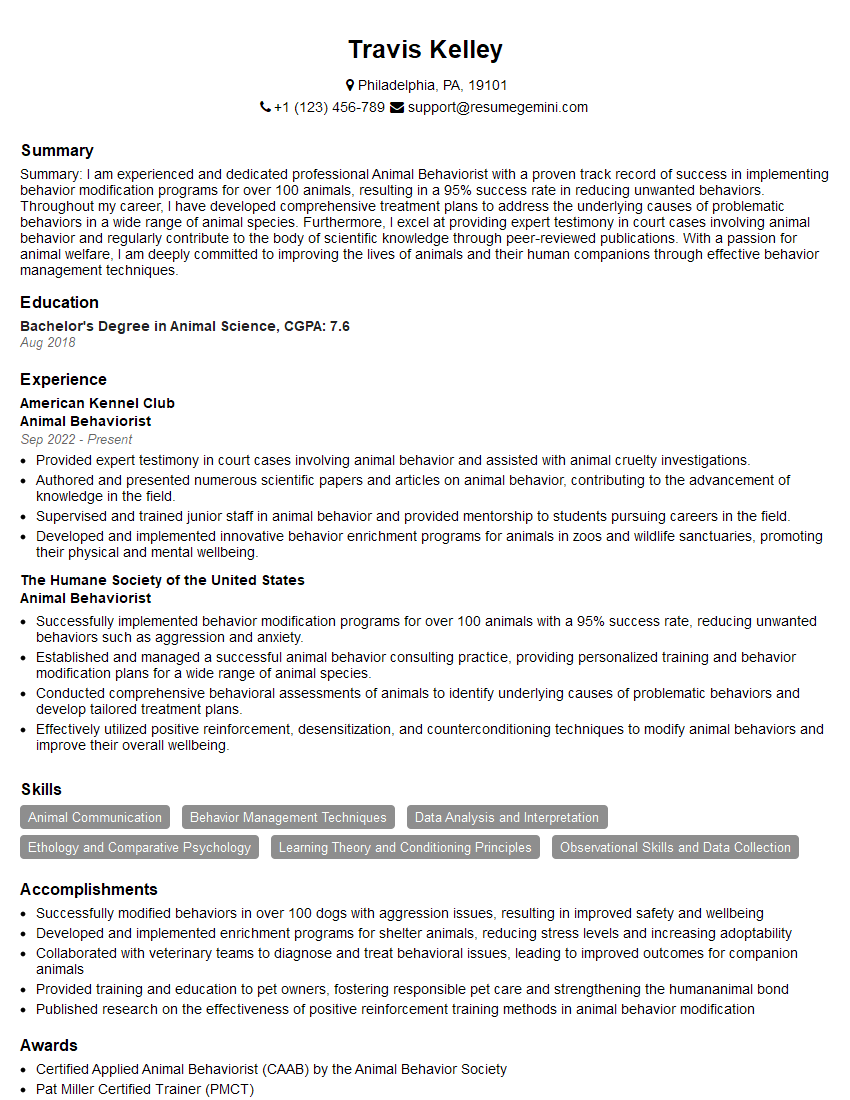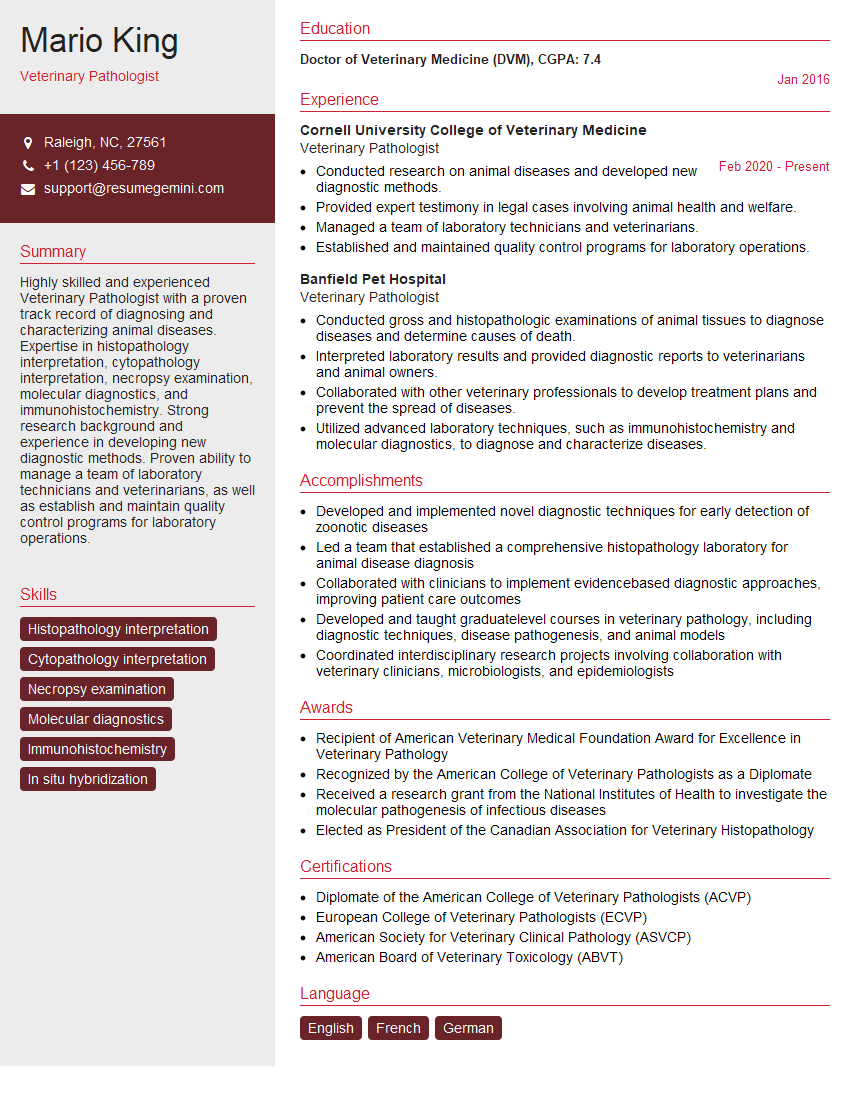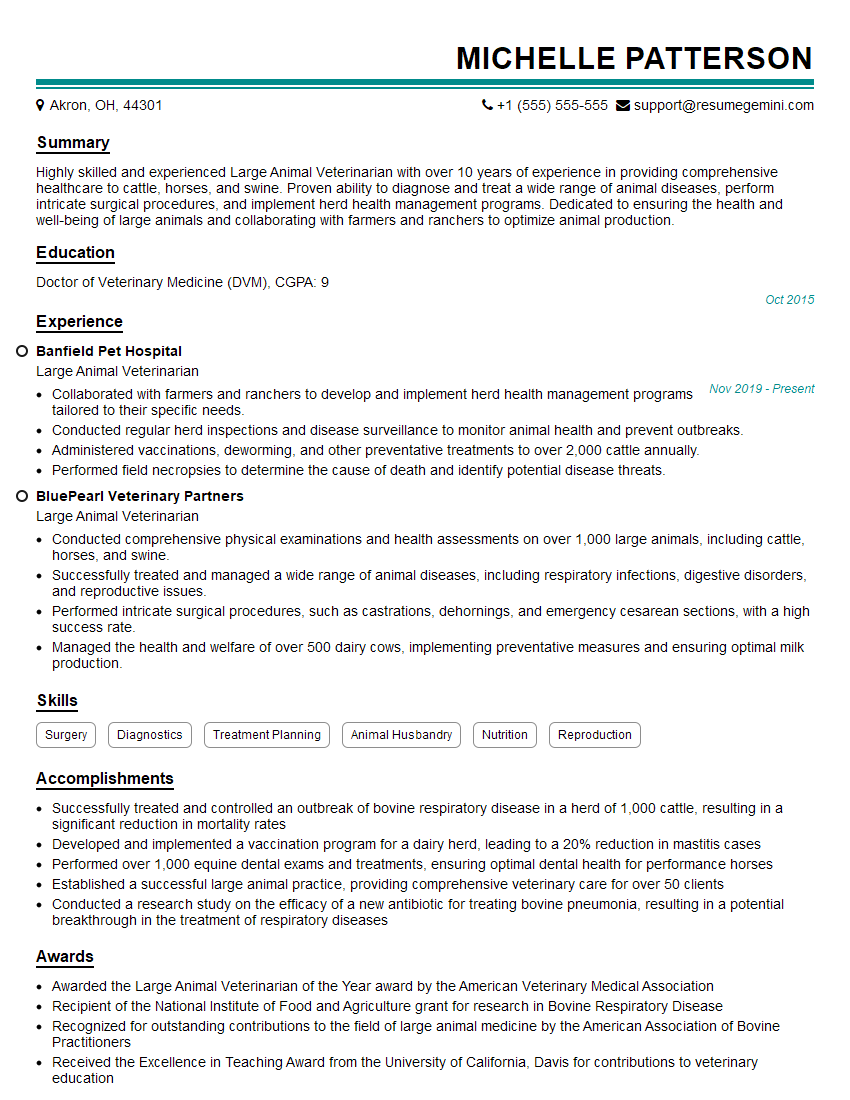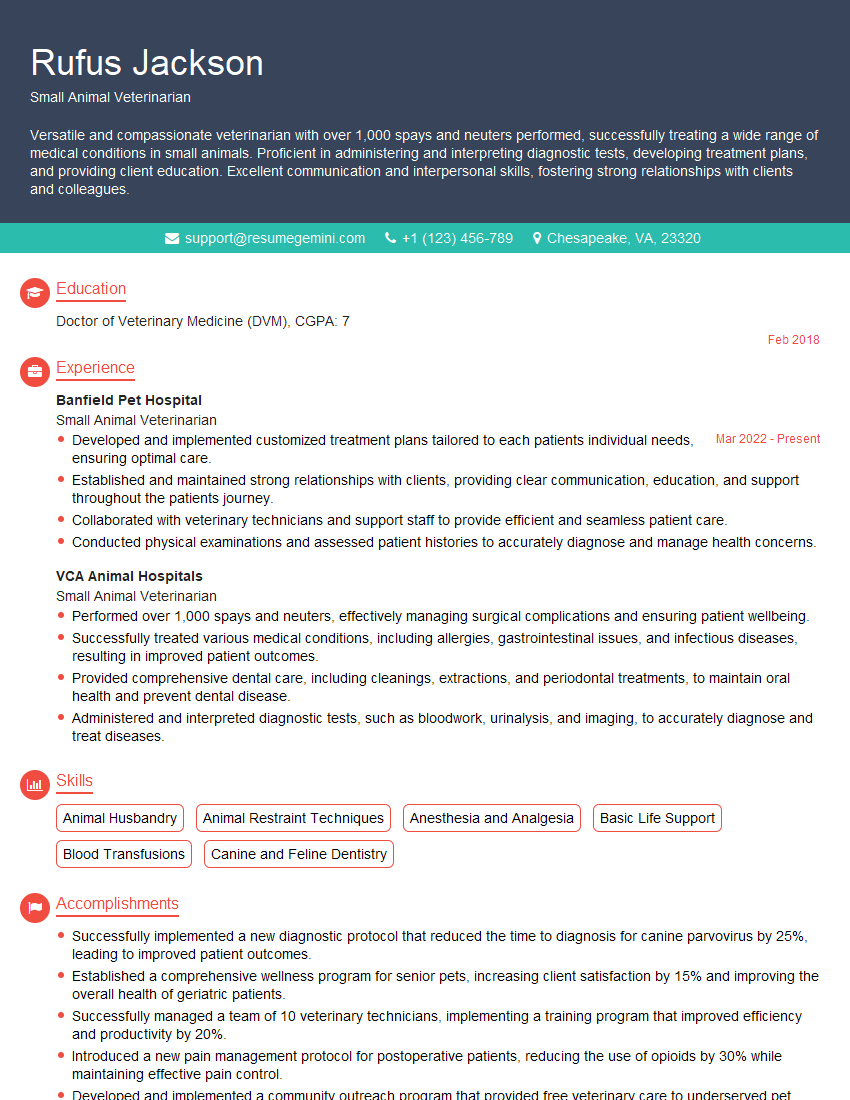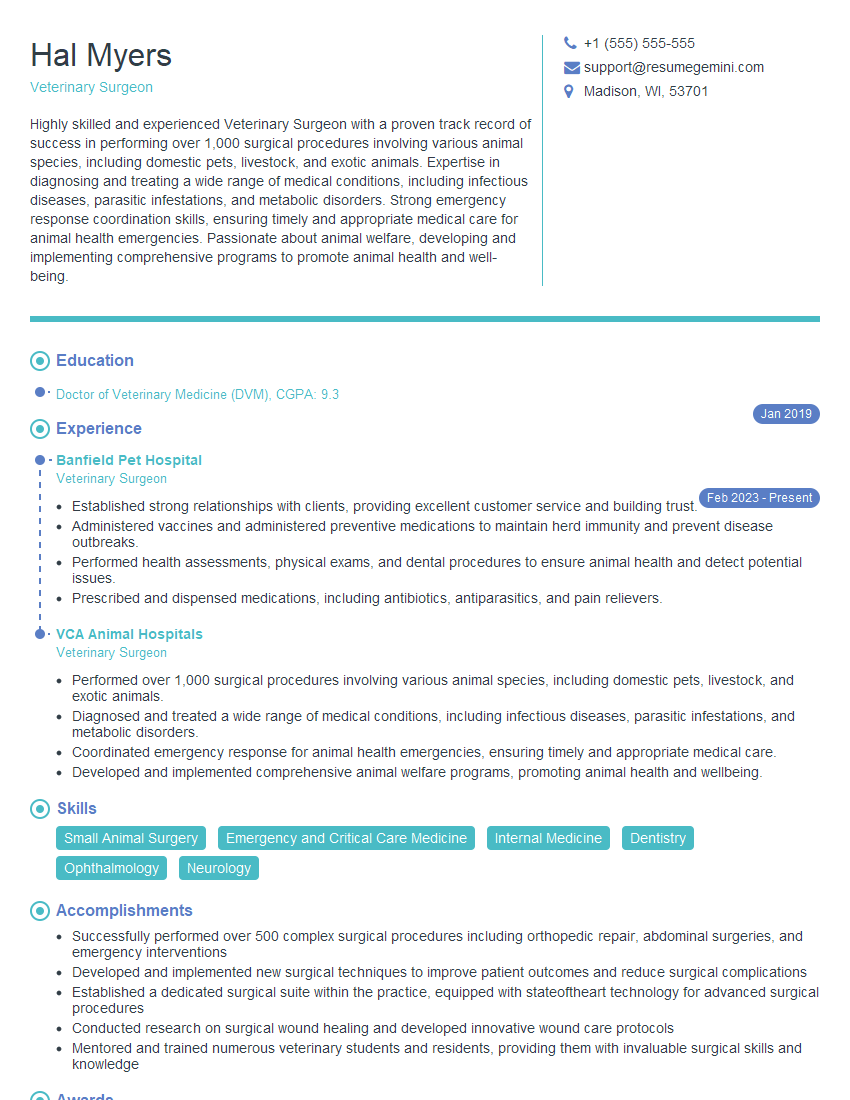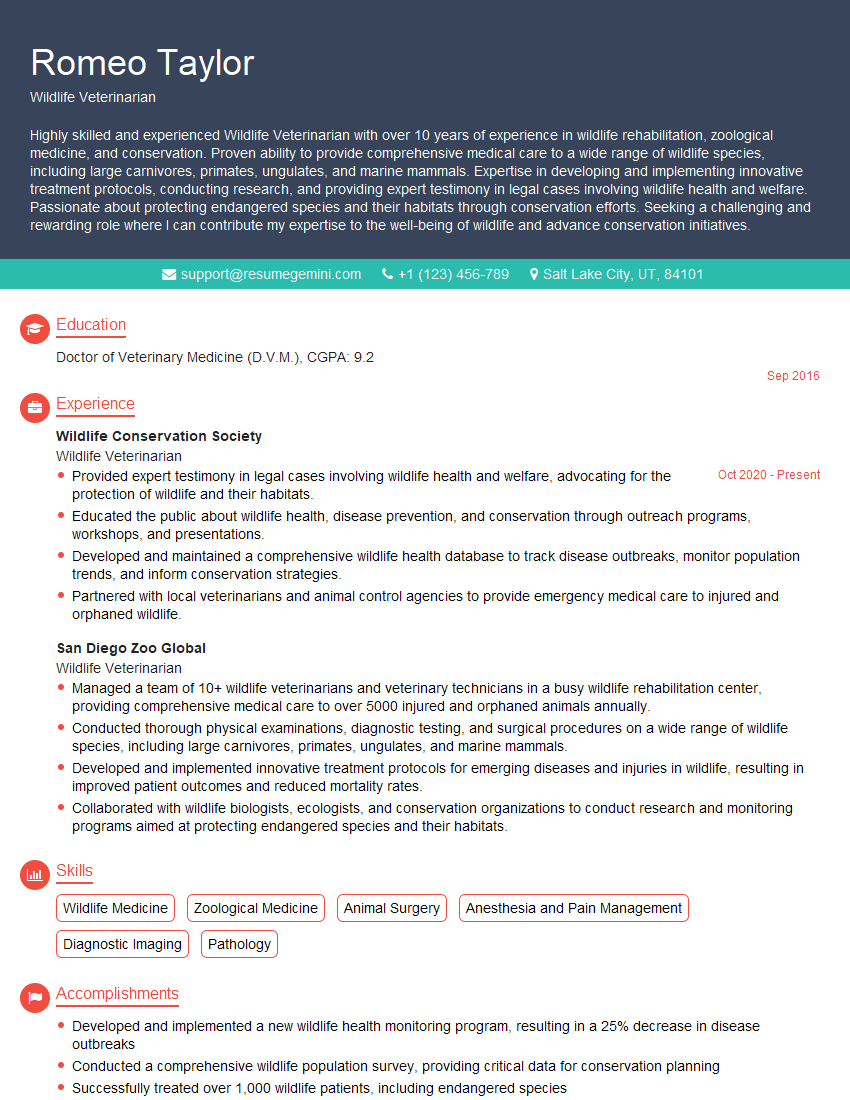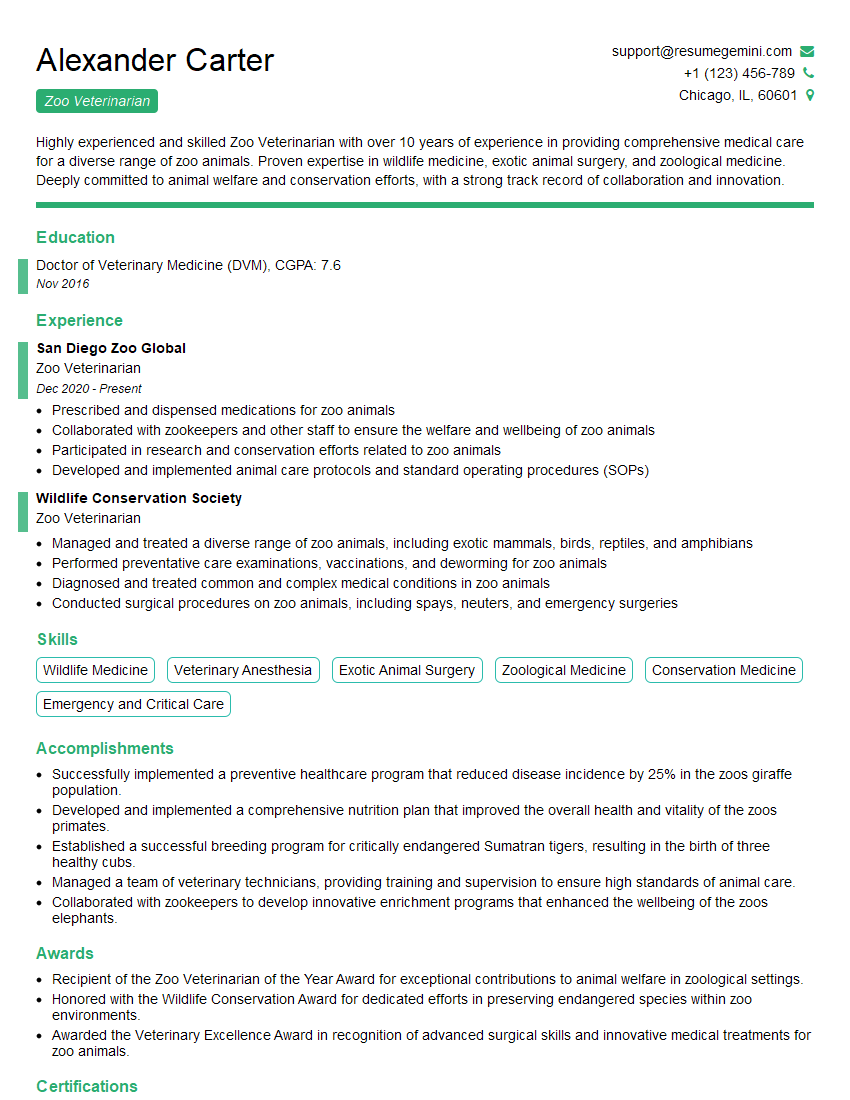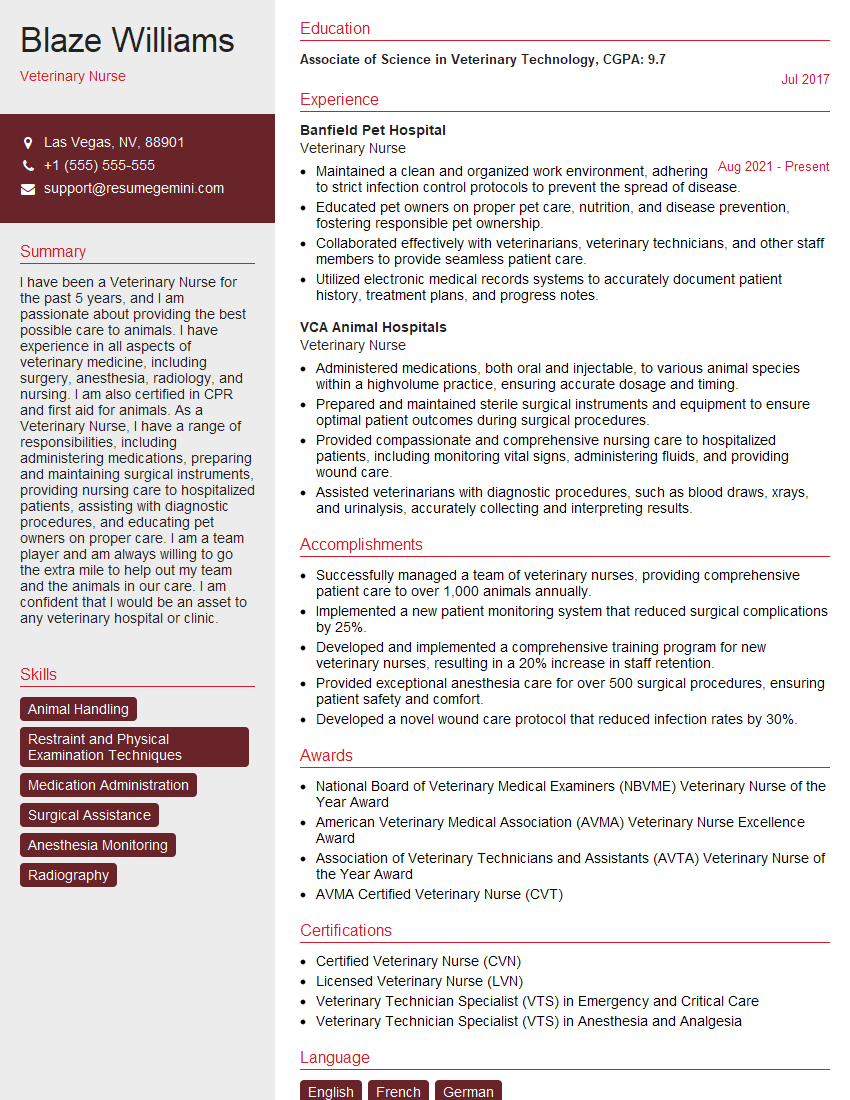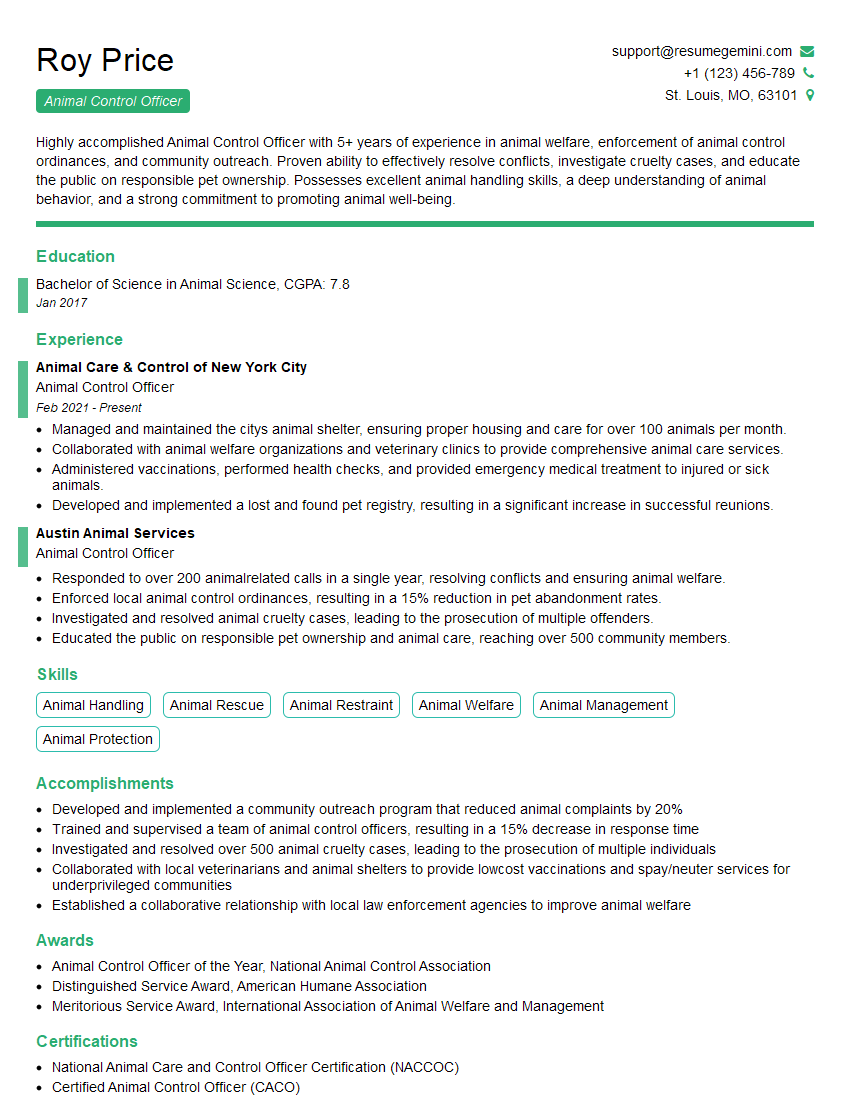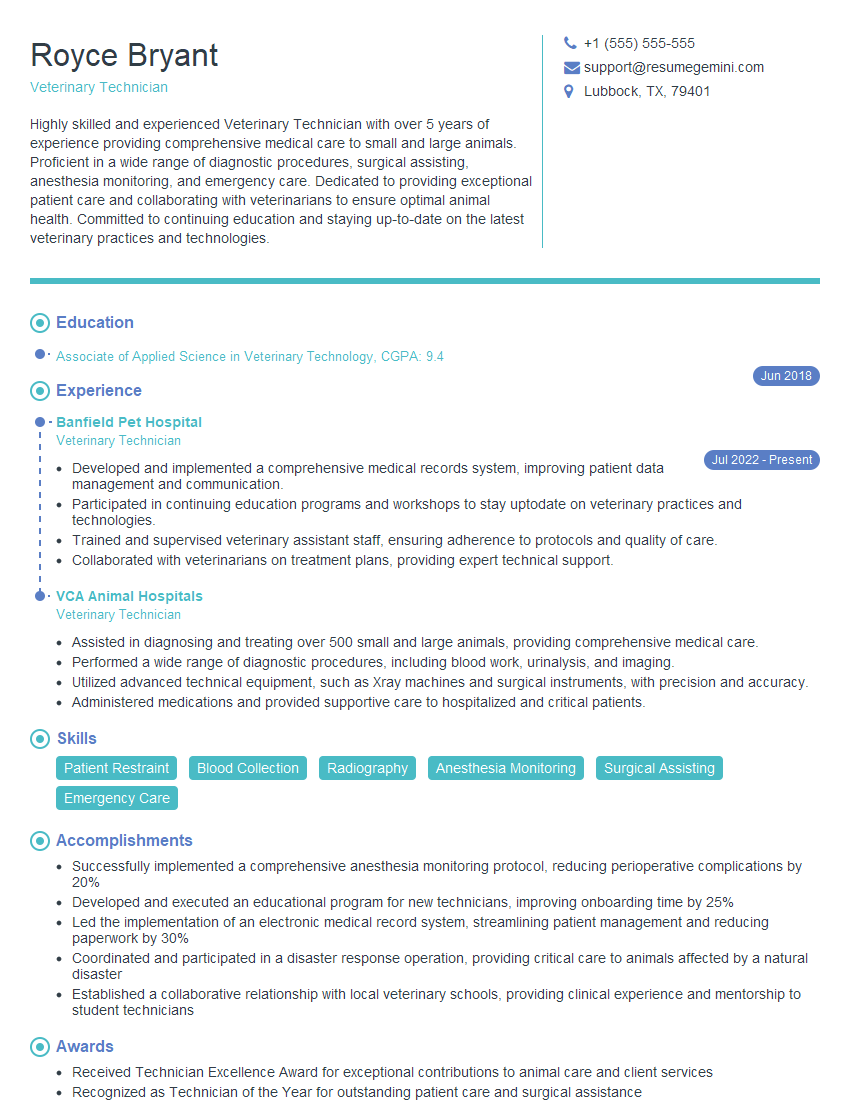Interviews are more than just a Q&A session—they’re a chance to prove your worth. This blog dives into essential Assessing Animal Health and Behavior interview questions and expert tips to help you align your answers with what hiring managers are looking for. Start preparing to shine!
Questions Asked in Assessing Animal Health and Behavior Interview
Q 1. Describe the common signs of feline upper respiratory infection.
Feline upper respiratory infections (URIs), commonly caused by viruses or bacteria, present with a range of symptoms. Think of it like a human cold, but in a cat. Early detection is crucial for effective treatment.
- Sneezing: Frequent sneezing is a hallmark sign. Imagine your cat having a persistent, almost uncontrollable sneeze fit.
- Nasal Discharge: This can range from clear to thick and greenish-yellow, indicating the severity and stage of the infection. Think about the different colors and textures of mucus you might have with a cold.
- Eye Discharge: Similar to nasal discharge, eye discharge can vary in color and consistency. It often makes their eyes appear crusty or sticky.
- Conjunctivitis: Inflammation of the conjunctiva (the membrane lining the eyelid) causes redness and swelling of the eyes.
- Lethargy and Depression: A cat with a URI often appears less active and more withdrawn than usual. This is their body telling them to rest.
- Loss of Appetite: A decreased interest in food is common due to discomfort and overall malaise.
- Coughing: While less frequent than other symptoms, coughing can occur, especially with more advanced infections.
If you notice these symptoms in your cat, it’s essential to consult a veterinarian promptly. Early intervention can prevent secondary infections and complications.
Q 2. Explain the difference between classical and operant conditioning in animal training.
Classical and operant conditioning are two fundamental learning processes in animal training. Think of it like teaching a dog a new trick: one method focuses on association, the other on consequences.
Classical Conditioning: This involves associating a neutral stimulus with a naturally occurring stimulus to elicit a specific response. Pavlov’s famous experiment with dogs is a great example. The dog naturally salivates (unconditioned response) at the sight of food (unconditioned stimulus). By repeatedly pairing the food with a bell (neutral stimulus), the bell eventually elicits salivation (conditioned response) even without the food. In dog training, this could mean pairing a leash with a treat, so the leash eventually becomes a positive stimulus.
Operant Conditioning: This focuses on the consequences of a behavior to increase or decrease its likelihood. It’s all about rewards and punishments. There are four main components: Positive Reinforcement (adding something desirable, like a treat, to increase a behavior), Negative Reinforcement (removing something undesirable, like pressure on a leash, to increase a behavior), Positive Punishment (adding something undesirable, like a scolding, to decrease a behavior), and Negative Punishment (removing something desirable, like attention, to decrease a behavior). For example, rewarding a dog for sitting (positive reinforcement) increases the likelihood of it sitting again. Ignoring a dog that’s jumping (negative punishment) decreases the jumping behavior.
Both methods are often used in combination for effective and humane animal training. For instance, you might use classical conditioning to make a clicker a positive stimulus and then use operant conditioning to reinforce the desired behavior using the clicker as a marker.
Q 3. What are the key indicators of canine hip dysplasia?
Canine hip dysplasia (CHD) is a debilitating condition affecting the hip joints. Imagine the ball-and-socket joint of the hip becoming loose and unstable. Early detection is vital to manage the condition and prevent further deterioration.
- Lameness or Limping: This is often subtle at first, particularly in younger dogs, and may be more noticeable after exercise. The dog may appear stiff or reluctant to move.
- Muscle Atrophy: Due to pain and limited use, the muscles around the hip may waste away, becoming thinner than normal.
- Difficulty Rising or Jumping: The dog may struggle to get up from a lying position or to jump onto furniture or into cars. Think about how you would feel trying to move with a painful hip.
- Altered Gait: The dog’s walk may appear stiff, stilted, or uneven; they may swing their hind legs out to the side or take shorter steps.
- Hip Clicks or Grinding Sounds: In some cases, you may hear clicking or grinding sounds coming from the hip joint when the dog moves.
- Pain on Palpation: A veterinarian can assess for pain by gently palpating the hip joints.
Radiographic examination (X-rays) is the definitive diagnostic tool for CHD. Early diagnosis and management, which may include weight management, physiotherapy, and sometimes surgery, are crucial for improving the dog’s quality of life.
Q 4. How would you assess the temperament of a dog during an adoption evaluation?
Assessing a dog’s temperament for adoption is crucial to ensure a safe and successful placement. It’s like a first date, but with a canine companion. You need to assess compatibility.
A structured approach is essential. This includes:
- Observation in a Controlled Environment: Observe the dog’s behavior in a quiet area, then in a more stimulating environment. Note its reactions to different stimuli.
- Interaction with People: Assess how the dog interacts with different people—adults and children if appropriate—observing its body language (relaxed, tense, fearful, aggressive) and approach.
- Leash Handling: Note the dog’s response to leash handling and walking; is it pulling, fearful, reactive, or well-behaved?
- Interaction with Other Animals (if applicable): If appropriate, observe the dog’s interaction with other dogs and cats; is it playful, aggressive, or indifferent?
- Response to Handling: Assess the dog’s response to gentle handling—examining teeth, ears, and paws; is it cooperative or fearful?
- Play Assessment: Observe how the dog plays; is it appropriate, over-excited, or aggressive? Note their body language and reaction when the play ends.
Thorough documentation of all observations is crucial. A combination of objective observations and subjective assessments allows for a comprehensive temperament profile, enhancing the likelihood of a successful adoption.
Q 5. List three methods for handling a stressed or aggressive animal.
Handling a stressed or aggressive animal requires a calm and methodical approach. Safety is paramount, both for the animal and the handler. Think of it like defusing a bomb—slow and steady wins the race.
- Create a Safe and Calm Environment: Reduce external stressors—noise, bright lights, sudden movements—to minimize the animal’s anxiety. A quiet, dimly lit room can often provide a sense of security.
- Approach Slowly and Calmly: Avoid sudden movements or loud noises. Let the animal approach you on its own terms whenever possible; respect its personal space and let it sniff you before approaching any further.
- Use Positive Reinforcement: Offer calming verbal cues, such as a soft, soothing voice. Offering high-value treats can help distract and calm the animal; building positive associations.
Remember that each animal is an individual, and the specific methods used will vary depending on the species, individual temperament, and the situation. In cases of extreme aggression, professional help from a certified animal behaviorist or veterinarian is crucial.
Q 6. Explain the importance of proper animal restraint techniques.
Proper animal restraint techniques are essential for safe and efficient handling during examinations, treatments, and other procedures. It’s all about safety—both for the animal and the handler.
Improper restraint can lead to injury to both the animal and the handler, increase stress levels in the animal, and compromise the accuracy of procedures. Think of it like safely securing cargo in a truck—you need to do it right to prevent damage and injury.
Key aspects of proper restraint include:
- Understanding Animal Behavior: Knowing species-specific behaviors and body language is crucial to anticipate potential reactions and to adjust your approach accordingly.
- Choosing the Right Technique: Different techniques are appropriate for different species and situations. For example, cats are usually best handled with minimal physical restraint, utilizing towels or other soft coverings; a large dog might need a more robust approach.
- Minimizing Stress: Employing gentle and calm handling techniques helps reduce stress and fear in the animal, thereby improving the safety and effectiveness of the procedure.
- Ensuring Safety: Utilizing appropriate equipment, such as muzzles, leads, and other restraint devices, as needed, protects both the handler and the animal.
Continuous education and training are vital to stay updated on best practices and refine restraint techniques.
Q 7. What are the ethical considerations in euthanasia?
Euthanasia, the act of ending an animal’s life painlessly, is a sensitive and ethically complex issue. It’s a deeply personal and often emotionally charged decision. Transparency and compassion are key.
Ethical considerations center around:
- Minimizing Pain and Suffering: The primary ethical imperative is to ensure a painless and peaceful death. This requires using humane and appropriate methods administered by qualified personnel.
- Informed Consent: Owners must be fully informed of the procedure, potential risks, and alternatives, allowing them to make an informed decision based on their understanding of their animal’s welfare. Compassionate communication is absolutely crucial here.
- Legality and Regulation: Euthanasia must be performed in accordance with all relevant laws and regulations to ensure compliance and prevent abuse.
- Appropriate Indications: Euthanasia should only be considered when suffering is unavoidable and other treatment options have been exhausted or deemed ineffective. This requires careful assessment of the animal’s condition.
- Emotional Support: Providing emotional and practical support to owners both before and after euthanasia is a key part of ethical practice. This may involve providing information and resources for grief support.
The ethical responsibility extends beyond the act itself to encompass the entire process, emphasizing compassion, transparency, and respect for both the animal and its owner.
Q 8. How would you diagnose and treat a case of bloat in a dog?
Bloat, or gastric dilatation-volvulus (GDV), is a life-threatening condition in dogs where the stomach fills with gas and twists on its axis, cutting off blood supply. Diagnosis involves immediate assessment of the dog’s abdomen – a visibly distended, tense abdomen is a key sign. The dog will likely be restless, exhibiting signs of pain and discomfort. Auscultation (listening with a stethoscope) may reveal diminished or absent bowel sounds. Radiography (X-rays) is crucial to confirm GDV and assess the extent of the twist. Treatment is an emergency procedure requiring immediate veterinary intervention. It often involves surgery to decompress the stomach (removing the gas) and untwist it. Intravenous fluids are administered to correct dehydration and electrolyte imbalances. Post-operative care includes pain management and close monitoring for complications.
Imagine a balloon inflated and twisted – that’s what happens to the dog’s stomach in GDV. Speed is critical; the longer it goes untreated, the greater the risk of organ damage and death.
Q 9. Describe the signs of rabies in a wild animal.
Rabies in wild animals can manifest in various ways, depending on the stage of infection and the species. Early signs are often subtle, including behavioral changes like increased aggression or unusual tameness (this is particularly concerning). Progressive stages may show signs of paralysis (often starting in the throat or jaw muscles, leading to difficulty swallowing), excessive salivation, and abnormal vocalizations. Animals may exhibit disorientation, staggering, and seizures. The final stage typically involves coma and death. It’s crucial to remember that rabies is a zoonotic disease, meaning it can transmit to humans. Therefore, any encounter with a wild animal exhibiting these symptoms needs immediate reporting to animal control.
Think of it like this: a wild animal behaving unusually – unusually friendly, unusually aggressive, or simply displaying neurological signs like stumbling or seizures – should always raise suspicion for rabies.
Q 10. How do you differentiate between normal and abnormal animal behavior?
Differentiating between normal and abnormal animal behavior requires understanding the species’ typical behavior, age, and breed. Normal behavior is species-specific and context-dependent. A playful nip from a puppy is different from an aggressive bite from an adult dog. Abnormal behavior is any deviation from this norm. This could include changes in appetite, sleep patterns, social interaction, elimination habits (urinating or defecating inappropriately), self-grooming (excessive licking or scratching), or vocalizations. Observing the animal in its usual environment and comparing its behavior to its past behavior helps ascertain normalcy. Veterinary input may be necessary for a proper diagnosis.
For example, a normally playful cat suddenly hiding and refusing food could indicate illness or stress. A dog suddenly becoming house-trained after being reliably trained could signal a medical or behavioral issue.
Q 11. What are the common parasites affecting domestic cats?
Domestic cats are susceptible to various parasites. Common internal parasites include roundworms (Toxocara cati), hookworms (Ancylostoma tubaeforme), and tapeworms (Dipylidium caninum). Roundworms and hookworms are transmitted through ingestion of infected feces or contaminated prey. Tapeworms are often acquired by ingesting fleas carrying the parasite’s larvae. External parasites frequently include fleas (Ctenocephalides felis), ticks (various species), and mites (Otodectes cynotis – ear mites). These parasites can cause various health problems such as anemia, intestinal blockage, skin irritation, and allergies. Regular fecal examinations and preventative treatments are vital for managing parasitic infestations in cats.
Think of it like this: just as humans get parasites, so do cats. Regular check-ups and preventative measures are key to keeping them healthy.
Q 12. Explain the role of vaccinations in animal health.
Vaccinations play a crucial role in maintaining animal health by preventing infectious diseases. They work by introducing a weakened or inactive form of a virus or bacteria into the animal’s body, stimulating the immune system to produce antibodies. These antibodies provide protection against future exposure to the actual pathogen. Core vaccines protect against common and potentially life-threatening diseases, while non-core vaccines target diseases more prevalent in specific regions or risk groups. Regular vaccination schedules are essential for maintaining immunity, especially as antibody levels decline over time. Vaccinations significantly reduce the morbidity and mortality rates associated with numerous infectious diseases.
Vaccination is like giving your pet a ‘protective shield’ against dangerous diseases. It’s an essential part of preventative healthcare.
Q 13. How would you manage a dog exhibiting separation anxiety?
Managing separation anxiety in dogs requires a multi-faceted approach. The goal is to desensitize the dog to the owner’s absence and build its confidence. This can be achieved through gradual desensitization and counter-conditioning. Start by leaving the dog alone for very short periods, gradually increasing the duration as it shows less anxiety. Provide enrichment activities like puzzle toys or chews to distract the dog while alone. A calming pheromone diffuser may help reduce anxiety. Medication, in some cases, can be used to manage severe anxiety under veterinary guidance. It’s crucial to address any underlying medical conditions that could contribute to the anxiety. Positive reinforcement training techniques such as rewarding calm behavior in the dog’s absence are also extremely helpful.
Think of it like teaching the dog that being alone isn’t scary. It’s a process that requires patience and consistency.
Q 14. Describe your experience with administering medication to animals.
My experience with administering medication to animals encompasses a wide range of techniques, from oral medications (pills, liquids) to injections (subcutaneous, intramuscular, intravenous). I’m proficient in choosing the appropriate administration route based on the medication, the animal’s species and temperament, and the dosage. I always prioritize safety, both for the animal and myself. This includes using proper restraint techniques, utilizing appropriate safety equipment (gloves, etc.), and ensuring accurate dosage. I am experienced in dealing with anxious or aggressive animals, employing techniques that minimize stress and ensure the safety of both the animal and myself. For example, I have successfully administered medications to a variety of species including dogs, cats, and small mammals, adjusting my approach based on each animal’s individual needs.
Safety and precision are paramount. Every animal is different, and I adapt my techniques accordingly.
Q 15. How would you handle a situation where an animal is injured during a procedure?
Handling an animal injury during a procedure requires immediate, calm, and efficient action. The first step is to immediately stop the procedure and assess the severity of the injury. This involves checking for bleeding, fractures, or other visible wounds. Then, prioritize the animal’s immediate comfort and safety. This might involve administering pain relief (if appropriate and authorized), controlling any bleeding with direct pressure or appropriate clotting agents, and immobilizing the injured area to prevent further damage. Next, depending on the severity, the animal may require immediate veterinary attention. This could range from a simple bandage to emergency surgery. Clear communication with the veterinary team is crucial throughout this process to ensure coordinated and effective care. For instance, if a cat suffered a paw laceration during a dental cleaning, I would immediately stop the cleaning, control the bleeding, clean the wound, and then contact the veterinarian to determine the need for stitches or other treatment. Detailed record-keeping of the incident, including the injury, actions taken, and the animal’s response, is critical for future reference and to improve procedures.
Career Expert Tips:
- Ace those interviews! Prepare effectively by reviewing the Top 50 Most Common Interview Questions on ResumeGemini.
- Navigate your job search with confidence! Explore a wide range of Career Tips on ResumeGemini. Learn about common challenges and recommendations to overcome them.
- Craft the perfect resume! Master the Art of Resume Writing with ResumeGemini’s guide. Showcase your unique qualifications and achievements effectively.
- Don’t miss out on holiday savings! Build your dream resume with ResumeGemini’s ATS optimized templates.
Q 16. Explain your understanding of animal anatomy and physiology.
Understanding animal anatomy and physiology is fundamental to assessing and maintaining animal health. It involves knowledge of the skeletal, muscular, nervous, circulatory, respiratory, digestive, urinary, and reproductive systems across different species. For example, knowing the location of major blood vessels is crucial for administering injections safely and effectively, while understanding digestive physiology helps us design balanced diets and diagnose gastrointestinal problems. Understanding species-specific differences is also critical; a cat’s anatomy is very different from a horse’s, requiring different approaches to examination and treatment. My knowledge extends beyond basic anatomy to include the functional aspects—how the various systems interact and maintain homeostasis. A deeper understanding allows for a more nuanced assessment of disease progression and treatment response. I frequently use anatomical atlases and physiological textbooks to refresh my knowledge and stay updated on the latest research and findings. This foundation is essential for making informed clinical decisions.
Q 17. What are the different types of animal housing and their suitability for various species?
Animal housing must meet the specific needs of each species to ensure their welfare. Different housing types exist, each with its own advantages and disadvantages. For example,:
- Cages: Suitable for smaller animals like rodents and rabbits, but cage size and enrichment are crucial to prevent stress and behavioral problems. Overcrowding can lead to aggression and disease spread.
- Runs/Pens: Offer more space than cages and are suitable for larger animals like dogs, pigs, or some primates. The design must provide appropriate substrate (bedding), shelter from the elements, and opportunities for enrichment activities.
- Stalls/Boxes: Typically used for horses or cattle, providing individual housing with sufficient space for movement. Stalls should be well-ventilated and cleaned regularly.
- Paddocks/Pastures: Larger outdoor areas ideal for herd animals allowing for natural behaviors like grazing and social interaction. Careful management of pasture quality and parasite control are essential.
- Aquariums/Vivariums: Specialized environments necessary for aquatic and reptile species respectively. Water quality, temperature, and humidity control are crucial for their survival.
The suitability of housing depends on factors like the species’ natural habitat, social structure, and physical needs. Failing to provide appropriate housing can lead to stress, illness, and behavioral issues.
Q 18. Describe the principles of a balanced diet for dogs and cats.
A balanced diet for dogs and cats should meet their species-specific nutritional requirements. This involves the correct balance of macronutrients (protein, fat, and carbohydrates), micronutrients (vitamins and minerals), and water. Dogs are omnivores, while cats are obligate carnivores, a key difference influencing their dietary needs. Cats require taurine, an amino acid, for heart and vision health, while dogs don’t have the same strict requirement. Commercial pet foods often cater to these needs with different formulations for age, breed size, and activity levels. However, it’s crucial to carefully check the ingredient list, ensuring high-quality protein sources and limited fillers. Homemade diets require careful formulation to ensure all necessary nutrients are included at correct levels, ideally under veterinary guidance to prevent deficiencies. Obesity is a significant problem in companion animals, so portion control is critical. Regular veterinary check-ups, including body condition scoring, help in monitoring nutritional status and adjusting the diet as needed. For instance, an active working dog will need a higher calorie diet than a sedentary senior dog. This personalized approach ensures optimal health and well-being.
Q 19. What are the common causes of lameness in horses?
Lameness in horses can stem from various causes, often involving the musculoskeletal system. These include:
- Injuries: These can range from soft tissue injuries like strains and sprains to fractures, tendon or ligament damage, and joint injuries (e.g., osteoarthritis).
- Infectious Diseases: Conditions like laminitis (inflammation of the sensitive laminae in the hoof), septic arthritis (infection of a joint), and bone infections can cause significant lameness.
- Metabolic Disorders: Conditions like Cushing’s disease and equine metabolic syndrome can impact the musculoskeletal system and lead to lameness.
- Developmental Problems: Congenital deformities or developmental orthopedic diseases can result in lameness.
- Farriery Issues: Incorrect shoeing or trimming can contribute to lameness.
Diagnosing the cause of lameness requires a thorough clinical examination, including observing the horse’s gait, palpating the limbs, and potentially using diagnostic imaging (X-rays, ultrasound) or advanced diagnostic tests like nerve blocks. Effective treatment depends on identifying the underlying cause and may involve rest, medication, therapy, and, in some cases, surgery.
Q 20. How would you assess the nutritional status of an animal?
Assessing an animal’s nutritional status involves a multi-faceted approach. This includes:
- Body Condition Scoring (BCS): A visual assessment of the animal’s fat reserves, providing a general indication of nutritional status. Different scoring systems exist for various species.
- Physical Examination: Checking for signs of malnutrition (e.g., weight loss, dull coat, poor muscle development) or overnutrition (e.g., obesity).
- Laboratory Tests: Blood tests can measure blood protein levels, electrolytes, and other indicators of nutritional status. Urinalysis can assess kidney function related to nutritional intake.
- Dietary History: Understanding the animal’s current diet—type, quantity, and frequency—is vital.
- Behavioral Observations: Assessing appetite, food selectivity, and overall activity levels can provide clues about nutritional issues.
Combining these methods provides a comprehensive picture. For example, a dog with a low BCS, dull coat, and low blood protein levels clearly indicates malnutrition, possibly requiring dietary changes or supplemental feeding.
Q 21. What is your experience with diagnostic imaging techniques (X-ray, Ultrasound)?
I have extensive experience with diagnostic imaging techniques, including X-ray and ultrasound. X-rays are valuable for detecting bone fractures, foreign bodies, and certain dental problems. Ultrasound is particularly useful for evaluating soft tissues, such as organs, muscles, tendons, and ligaments. My experience encompasses both acquiring images and interpreting the findings to assist in diagnosis. For example, I’ve used X-rays to diagnose fractures in horses and dogs and utilized ultrasound to assess pregnancies in various species and to image internal organs for disease detection. I’m proficient in interpreting the images and correlating them with clinical findings. This skill is essential for making accurate diagnoses and guiding treatment decisions. Moreover, I understand the limitations of each technique and know when to utilize other diagnostic modalities to reach a more complete diagnosis. For instance, I understand that while ultrasound is excellent for soft tissues, it may not be sufficient for bone evaluations, necessitating X-ray usage.
Q 22. Explain the importance of record-keeping in animal care.
Meticulous record-keeping is the cornerstone of responsible animal care. It’s not just about documenting treatments; it’s about building a comprehensive health history that allows for informed decision-making, trend identification, and ultimately, improved animal welfare. Think of it as a patient’s medical chart, but for our animal companions.
- Individual Animal Records: These should include details like species, breed, age, date of acquisition, vaccination history, medical history (including illnesses, surgeries, and medications), behavioral observations, and any dietary restrictions. For example, a detailed note about a dog’s allergy to specific food brands can prevent future health crises.
- Treatment Records: Every administration of medication, procedure performed, or diagnostic test conducted needs to be precisely recorded, including the date, time, dosage, and the individual administering the treatment. This is crucial for tracking treatment efficacy and identifying potential adverse reactions.
- Facility-Level Records (for Shelters/Clinics): Larger facilities require records detailing population demographics, disease outbreaks, inventory management (food, medication, supplies), and staff training. This helps identify trends, improve resource allocation and even aid in identifying disease patterns, allowing for proactive prevention strategies.
Effective record-keeping allows for continuous monitoring, early detection of health problems, and informed treatment strategies, enhancing the overall well-being and longevity of the animals under our care.
Q 23. Describe your approach to conflict resolution with pet owners.
Conflict resolution with pet owners requires empathy, patience, and a collaborative approach. My strategy focuses on clear communication, active listening, and finding mutually agreeable solutions. I believe in building trust and understanding before addressing the conflict itself.
- Active Listening: I start by carefully listening to the owner’s concerns without interruption. I try to understand their perspective, even if I don’t initially agree. For instance, if an owner believes their dog’s behavior is inexplicable, I listen and empathize before presenting the diagnostic approach.
- Clear and Empathetic Communication: I explain the situation in clear, non-judgmental language, avoiding veterinary jargon. I use simple terms, analogies, and visual aids if needed. Suppose a cat isn’t using the litter box; I’d explain the potential underlying medical or behavioral issues in layman’s terms, instead of diving into complex terminology.
- Collaborative Problem-Solving: I work with the owner to create a treatment or management plan they are comfortable with and can follow. This involves discussing the pros and cons of various options, considering their budget and lifestyle. Maybe a behavioral modification plan is more realistic than extensive veterinary intervention in a particular circumstance.
- Follow-up: I ensure regular follow-ups to monitor progress and adjust the plan as needed. Open communication is vital; I encourage the owner to contact me with any questions or concerns.
By focusing on collaboration and empathy, I aim to create a positive, trust-based relationship that ensures the best possible outcome for both the pet and the owner.
Q 24. How would you identify and manage an outbreak of disease in a shelter environment?
Managing a disease outbreak in a shelter requires swift, decisive action to prevent its spread. The first step involves rapid identification of the affected animals and implementing strict quarantine protocols.
- Rapid Assessment: I would immediately isolate any animals showing signs of illness. This involves careful observation for any unusual behavior, changes in appetite, respiratory distress, diarrhea, or other symptoms. We’d then assess animals at risk that may be incubating the disease.
- Quarantine and Isolation: Strict quarantine procedures would be implemented, separating sick animals from healthy ones. This limits the spread of the disease. We’d dedicate specific staff and equipment for the quarantine area to avoid cross-contamination.
- Sample Collection and Laboratory Analysis: Samples (fecal, blood, etc.) would be collected from affected animals and sent to a veterinary diagnostic laboratory for analysis. The lab results would identify the specific pathogen and inform treatment strategies.
- Treatment and Prevention: Based on the laboratory results, appropriate treatment would be administered. Preventive measures, such as vaccination and disinfection of the facility, would be implemented to prevent further spread. This may include environmental cleaning with specific disinfectants to eliminate the pathogen and strict hygiene protocols for personnel.
- Contact Tracing: If possible, we trace contacts of the affected animals to identify and monitor potential carriers. This might include reviewing recent intakes or identifying animals that might have had contact with the source of infection.
- Reporting: Authorities like the local health department or animal control should be notified about the outbreak. This ensures public safety and coordination of broader public health measures.
A proactive approach including regular preventative health checks, and vaccinations coupled with strict hygiene protocols are key to minimizing outbreaks. This situation highlights the importance of robust health records for contact tracing and management of disease.
Q 25. Describe the different types of animal restraint devices and their appropriate use.
Animal restraint is essential for safe and effective examination, treatment, and handling. The choice of restraint method depends on the species, size, temperament, and the procedure being performed. Safety for both the animal and the handler is paramount.
- Physical Restraint: This involves using your body to control the animal. Techniques vary greatly by species. For example, a gentle but firm hold on a cat’s scruff can be calming and help reduce stress. It is crucial to know which type of physical restraint minimizes stress and trauma.
- Chemical Restraint: Sedatives or anesthetics are used for procedures requiring complete immobilization or to reduce stress in anxious animals. This requires careful consideration of the animal’s species and health status, and should always be performed by or under the supervision of a licensed veterinarian.
- Mechanical Restraint: Devices like leashes, muzzles, nets, or specialized animal carriers are used to control movement. Muzzles are used to prevent biting in dogs, and nets are useful for safely capturing wildlife. The use should always consider the animal’s comfort and welfare, avoiding causing any pain or injury.
- Environmental Restraint: Creating a calm and secure environment reduces the need for physical restraint. For example, placing a fearful animal in a small, confined space might make handling safer.
Improper restraint can lead to injury to both the animal and the handler. Therefore, proper training and understanding of animal behavior are essential for choosing and using restraint methods appropriately.
Q 26. What are your preferred methods for collecting animal samples for laboratory analysis?
Collecting animal samples requires attention to detail and proper aseptic techniques to ensure sample integrity and prevent contamination. The method varies based on the type of sample and the intended analysis.
- Blood Collection: Venipuncture (drawing blood from a vein) is common. The vein selection varies based on the animal species and size; in dogs and cats, we often use the jugular or cephalic vein. Appropriate needle size and collection tubes must be selected, with anticoagulants used as needed. All equipment must be sterile.
- Urine Collection: Methods include free-catch (for mid-stream urine samples), cystocentesis (directly aspirating urine from the bladder with a needle), or catheterization (inserting a tube into the bladder). Sterile collection is crucial for urinalysis.
- Fecal Collection: Fresh fecal samples are collected directly from the rectum or from the ground (if the animal defecated recently). It’s vital to collect the sample in a clean, leak-proof container, and the sample should be preserved correctly, especially if there is a delay in getting to the lab.
- Saliva Collection: Depending on the animal, saliva can be collected passively (allowing natural saliva accumulation) or using specialized collection swabs.
- Swabs: Swabs can be used to collect samples from mucous membranes (oral, nasal, etc.) or wounds. The selection of the appropriate swab is based on the purpose of the test.
Proper labeling of samples with the animal’s identification, date, and time of collection is critical. It also avoids confusion and allows correct interpretation of laboratory results.
Q 27. How would you educate a client about proper pet hygiene and preventative care?
Educating clients on proper pet hygiene and preventative care is crucial for maintaining their pet’s health and well-being. I use a combination of clear explanations, visual aids, and personalized recommendations tailored to their lifestyle.
- Grooming: Regular brushing, bathing, and nail trimming are essential. I show clients proper techniques and recommend products suitable for their pet’s coat type. For example, I would explain that specific brushes are needed for different coat textures, such as for long-haired versus short-haired breeds.
- Dental Hygiene: I emphasize the importance of regular teeth brushing and professional dental cleanings, explaining the link between poor oral hygiene and systemic health problems.
- Parasite Prevention: I discuss various parasite prevention methods like flea, tick, and heartworm medications, tailored to the region’s climate and parasite prevalence. I ensure they understand the correct administration methods and potential side effects.
- Vaccination: I review the recommended vaccination schedule for their pet, explaining the importance of each vaccine and its associated risks and benefits.
- Nutrition: I provide guidance on choosing appropriate nutrition based on their pet’s age, breed, and activity level, addressing any misconceptions around popular pet food choices.
- Environmental Enrichment: I encourage clients to provide mental and physical stimulation for their pets to prevent behavioral problems and promote their overall health.
Education isn’t a one-time event; I follow up with clients to answer questions and address any concerns they may have. My goal is to empower pet owners to make informed decisions to maintain their pet’s health and happiness.
Q 28. Explain the process of performing a physical examination on a variety of animal species.
Performing a thorough physical examination is fundamental to assessing an animal’s health. The specific techniques used vary among species, but the overall approach is consistent: observation, palpation, auscultation, and, where appropriate, specialized testing.
- Observation: This begins the moment you meet the animal. Note the animal’s posture, gait, demeanor, respiratory effort, and overall body condition. Is the animal alert and responsive, or lethargic and depressed? Does it have any visible injuries, masses, or skin abnormalities?
- Palpation: This involves feeling different parts of the body to assess temperature, texture, and the presence of masses or pain. For example, feeling the abdomen can reveal abnormalities like distension or pain.
- Auscultation: Listening to the heart, lungs, and abdomen using a stethoscope provides crucial information about organ function. Heart murmurs, abnormal lung sounds, or intestinal sounds can indicate illness.
- Species-Specific Considerations: A physical exam for a bird includes examination of its feathers and beak, while a reptile’s exam might include assessment of its scales and overall hydration. Each species presents unique challenges and nuances that require species-specific knowledge.
- Specialized Tests: Depending on the clinical signs and history, specialized diagnostic tools might be used, such as radiographs (x-rays), blood work, urinalysis, or other laboratory tests.
Performing accurate and thorough physical exams, combined with relevant diagnostic testing, allows for early identification of health issues, enabling timely intervention and better prognoses.
Key Topics to Learn for Assessing Animal Health and Behavior Interview
- Animal Anatomy and Physiology: Understanding normal physiological functions is crucial for recognizing deviations indicative of illness or distress. This includes knowledge of various species-specific systems.
- Behavioral Observation Techniques: Mastering systematic observation, record-keeping, and ethogram creation for accurate assessment of animal behavior. Practical application includes identifying subtle changes in posture, vocalizations, and activity levels.
- Disease Recognition and Diagnostic Procedures: Familiarize yourself with common diseases and their clinical signs across various animal species. Understand the role of physical examinations, diagnostic testing (e.g., blood work, imaging), and sample collection.
- Stress and Welfare Assessment: Learn to assess animal welfare using established indicators and understand the impact of environmental factors, management practices, and human interaction on animal stress levels.
- Data Analysis and Interpretation: Practice interpreting data from behavioral observations and diagnostic tests to formulate accurate diagnoses and treatment plans. This includes understanding statistical concepts relevant to animal health research.
- Ethical Considerations in Animal Care: Demonstrate your understanding of ethical principles in animal research, welfare, and handling. This includes knowledge of relevant legislation and regulations.
- Communication and Collaboration: Practice clearly communicating your assessments and recommendations to colleagues, clients, and other stakeholders. Effective teamwork and problem-solving skills are essential.
Next Steps
Mastering the assessment of animal health and behavior is vital for a successful and rewarding career in veterinary medicine, animal science, or related fields. A strong understanding of these concepts will significantly enhance your job prospects and open doors to exciting opportunities. To maximize your chances, creating an ATS-friendly resume is crucial. ResumeGemini is a trusted resource that can help you build a compelling resume that highlights your skills and experience effectively. Examples of resumes tailored to Assessing Animal Health and Behavior are available within ResumeGemini to guide you.
Explore more articles
Users Rating of Our Blogs
Share Your Experience
We value your feedback! Please rate our content and share your thoughts (optional).
What Readers Say About Our Blog
Hello,
We found issues with your domain’s email setup that may be sending your messages to spam or blocking them completely. InboxShield Mini shows you how to fix it in minutes — no tech skills required.
Scan your domain now for details: https://inboxshield-mini.com/
— Adam @ InboxShield Mini
Reply STOP to unsubscribe
Hi, are you owner of interviewgemini.com? What if I told you I could help you find extra time in your schedule, reconnect with leads you didn’t even realize you missed, and bring in more “I want to work with you” conversations, without increasing your ad spend or hiring a full-time employee?
All with a flexible, budget-friendly service that could easily pay for itself. Sounds good?
Would it be nice to jump on a quick 10-minute call so I can show you exactly how we make this work?
Best,
Hapei
Marketing Director
Hey, I know you’re the owner of interviewgemini.com. I’ll be quick.
Fundraising for your business is tough and time-consuming. We make it easier by guaranteeing two private investor meetings each month, for six months. No demos, no pitch events – just direct introductions to active investors matched to your startup.
If youR17;re raising, this could help you build real momentum. Want me to send more info?
Hi, I represent an SEO company that specialises in getting you AI citations and higher rankings on Google. I’d like to offer you a 100% free SEO audit for your website. Would you be interested?
Hi, I represent an SEO company that specialises in getting you AI citations and higher rankings on Google. I’d like to offer you a 100% free SEO audit for your website. Would you be interested?
good
